
Features
Operations
In support of heavy lifters
Talk of new fixed-wing search-and-rescue aircraft (SAR) for the Royal Canadian Air Force (RCAF) first surfaced in 2002 in the last gasps of the Chretien government.
January 4, 2013 By Paul dixon
Talk of new fixed-wing search-and-rescue aircraft (SAR) for the Royal Canadian Air Force (RCAF) first surfaced in 2002 in the last gasps of the Chretien government. Now, 10 years later, there may be light at the end of the tunnel, albeit still a faint light. The RCAF FWSAR project was initially derailed in 2004 by criticism from the defense industry that had written the aircraft specification in such as way as to exclude all contenders but one. For the next few years, the FWSAR project languished as other matters took precedence, such as the War in Afghanistan, acquisition of the C-17 Globemaster, C-130J Hercules and CH-147 Chinook and the ongoing saga of the CH-148 Cyclone, to name just a few.
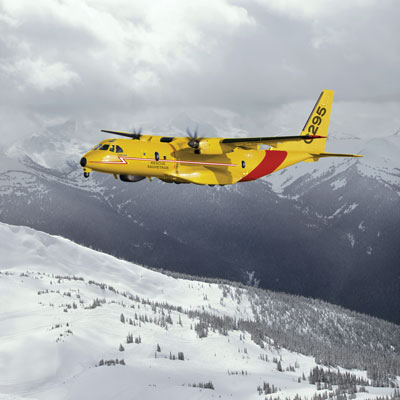 |
|
| The C-295’s maximum range of 3,040 nautical miles places all of Canada’s search-and-rescue area of responsibility in its reach within one crew day from existing SAR bases. Photo: Airbus
|
In 2008, the federal government introduced its Canada First Defence Strategy. The report examined increasing funding to the military, enhancing the capacity of the Canadian Forces by investment in the foundation of military capabilities, with one of the five key areas specifically identified as being the acquisition of 17 fixed-wing search-and-rescue (FWSAR) aircraft. The paper goes on to address partnership with Canadian industry and the positive impact it will have in enabling Canadian industry to develop skills and talents that will allow them to compete more equitably in the world market.
In 2009, the government invited input from the Canadian aerospace industry on requirements for the FWSAR project. This was reviewed by the DND, Public Works and Government Services Canada (PWGSC) and Industry Canada (IC), and was hailed by the government as an example of its commitment to consult with industry on major projects. The government then tasked the National Research Council Canada (NRC) to conduct an independent review of the FWSAR statement of operational requirements (SOR), first written in 2004. This was the document that had been cited as being written to exclude all but one specific aircraft. In its report, the NRC recommended improving the technical requirements and other criteria that were used as justification for the choice that was made in 2004.
In 2010, the NRC submitted its report to the government and the document was reviewed by the DND, PWGSC and IC. Based on that report, the Air Force revised the statement of requirements (SOR). Unlike the 2004 SOR, specifications are now much broader.
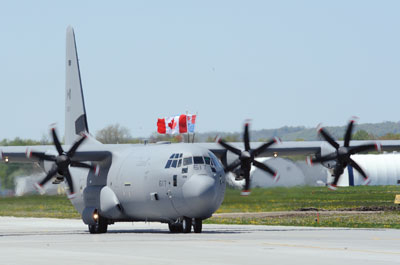 |
|
| The 17th and final aircraft of Canada’s new CC-130J Hercules fleet lands at 8 Wing Trenton, Ont., last May. The C-130J is one of the aircraft being considered for a FWSAR role. Photo: Cpl. Darcy Lefebvre, Royal Canadian Air Force |
For consideration in the competition, companies must demonstrate that their aircraft are capable of covering the country’s three search-and-rescue geographic sectors; have the capacity to carry the wide range of equipment and personal gear required for a wide range of operations; be equipped with a rear-loading ramp; and be able to conduct operations within the standard crew-day model. The rear ramp on the aircraft is required to eliminate the risk of injury SAR techs may be exposed to when jumping from a side door exit. More importantly, the rear ramp gives the jump master maximum overview of the situation, optimizing operational efficiency and safety.
Beyond the aircraft performance specifications and criteria, there is the technology that must be included, a full suite of radar and multi-spectral electro-optical/infrared (EO/IR) that would enable all-weather day/night detection and identification of a wide range of targets. The military is not simply buying an aircraft, but rather buying an aircraft that comes with a Canadian company (known as the Canadian In-Service Support (ISS) Integrator) to provide the in-service support for the aircraft including all the associated sub-systems (technology).
In the September/October 2012 issue of Wings, we kicked off our detailed look of the FWSAR project by outlining top contenders for the contract, along with key details about the specifications of the aircraft. In the November/December 2012 issue, we reported on B.C.’s Viking Air and its DHC-5 NG Buffalo as the replacement for the current CC-115 Buffalo. Viking may be in a unique situation in the FWSAR, as both OEM and ISS Integrator. Here are two more contenders for the job: the EADS/CASA C-295 and the Lockheed Martin C-130J.
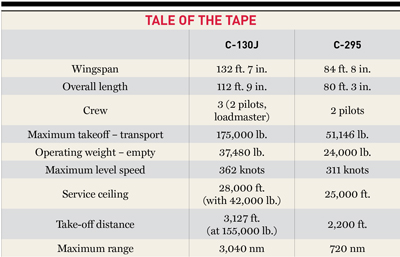 |
Value Added: EADS/CASA C-295
The EADS C-295 is Airbus Military’s entrant into the FWSAR competition, with Discovery Air of Yellowknife as its ISS partner. The C-295 is the stretch version of Airbus’ C-235, with a larger payload and different engines. There are more than 100 of the aircraft, which is built at Airbus military facilities in Spain, in service with 13 countries around the world as multi-role tactical transports. Chile is one of several countries using the twin-engine C-295 in the long-range maritime patrol role, replacing its aging and larger four-engine P3 Orions.
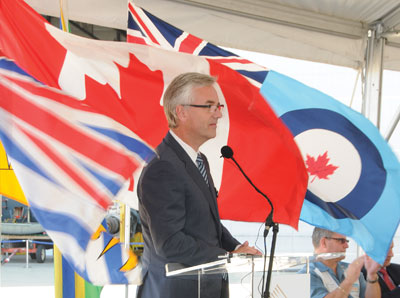 |
|
| David Schellenberg, CEO of Cascade Aerospace, was honoured and privileged when Lockheed Martin named Cascade Aerospace one of only two Lockheed Martin-authorized Hercules Service Centres in the western hemisphere. PHOTO: PAUL DIXON
|
Airbus Military markets the C-295 as being versatile and robust, with the lowest-cost life cycle of any aircraft in its class. With the largest cabin volume and floor space out there, the C-295 offers space for storage of all SAR gear while providing space for crew rest and preparation – including galley and toilet, optional data management console, stretchers for medevac operations, and four ergonomically designed spotter seats for maximum comfort during extended searches. The rear ramp is certified and proven in static line parachute egress as well as 450-pound aerial delivery by static line.
The C-295’s maximum range of 3,040 nautical miles (nm) places all of Canada’s SAR area of responsibility in its reach within one crew day from existing SAR bases. Airbus claims the C-295 has the lowest life-cycle costs in its class compared to its competitors, which translates into a potential savings of up to $1 billion in operating costs.
In October 2012, at a ceremony in Yellowknife, Airbus Military signed a memorandum of understanding with Discovery Air that would see Airbus provide the aircraft and Discovery Air the training, engineering and maintenance for the 20-year cycle of the FWSAR project. Discovery Air Inc. is a Canadian specialty aviation company, offering a wide range of aviation services in a number of locations across the country.
Through its subsidiaries Air Tindi and Great Slave Helicopters, Discovery Air has the experience of providing air service across Canada’s north and into the high arctic on a year-round basis. Discovery Air Technical Services (DATS) boasts an 80,000-square-foot facility located at Jean Lesage Airport in Quebec City. DATS provides a wide range of services, with certification from Transport Canada, the Federal Aviation Administration and the European Aviation Safety Agency.
Discovery has also established ongoing business relationships with the Canadian military. Top Aces, another Discovery subsidiary, is the exclusive supplier of combat airborne training services to all branches of the Canadian Forces. Flying as Red Team, Top Aces provides realistic training scenarios and exercises for air and surface personnel. Discovery Air is a leading sponsor of Hawk One, the classic RCAF F-86 Sabre operated by Vintage Wings of Canada.
With a longer cabin than the C-27J, the C-295 can hold more pallets of cargo or medical litters, and its air-to-air refueling capability extends the aircraft’s range. Though some have criticized its slower cruising speed of 260 knots, the company claims that Portugal picked the C-295 precisely because of its low and slow capability. EADS has brought onboard Pratt & Whitney Canada for the engines and Thales Canada for the avionics.
The merits of the C-130J
Kelly Johnson, godfather of Lockheed’s legendary Skunkworks, called the C-130 Hercules the ugliest airplane he had ever seen when it was originally unveiled more than half a century ago. Looks notwithstanding, the C-130 is still going strong, one of a handful of aircraft in the world that has flown for its original purchaser for more than 50 years. The RCAF accepted delivery of its first C-130B in October, 1960. The aircraft has proven itself to be a reliable heavy-lifter, supporting missions across Canada and abroad under extremes of climate, geography and human misconduct.
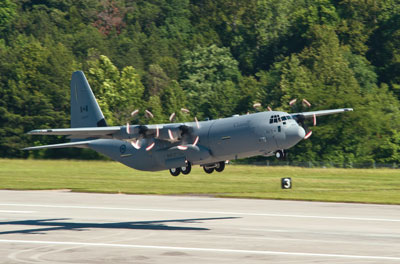 |
|
| Costs are offset when comparing the CC-130H with the CC-130J, as the CC-130J does not require a flight engineer and can fly operations with a flight crew of three – two pilots and a loadmaster. Photo: Lockheed Martin |
The RCAF has utilized the C-130H as a primary SAR aircraft from bases in Winnipeg, Trenton and Greenwood for a number of years. It is quite obvious that many RCAF personnel have become fond of the aircraft for a number of very good reasons and actively support transitioning to the CC-130J for SAR purposes. One of the obstacles facing the C-130J is the question of operating costs in comparison to twin-engine competitors. Costs are offset when comparing with the C-130H as the C-130J does not require a flight engineer and can fly operations with a flight crew of three – two pilots and a loadmaster.
Last August at the 50th Abbotsford International Air Show, Lockheed Martin announced that Cascade Aerospace of Abbotsford, B.C. (which was purchased by Halifax, N.S.-based IMP Group in November 2012) would be authorized as a C-130 Heavy Maintenance Centre, only the second such centre in the world.
Cascade is one of only two Lockheed Martin-authorized Hercules Service Centers in the western hemisphere and one of 13 worldwide. An HMC is a centre that is authorized to do work on the new C-130J aircraft whereas an HSC is authorized to do work on the legacy C-130B-H aircraft. Lockheed Martin had awarded a 20-year contract in 2010 to Cascade for maintenance services to support Canada’s new CC-130Js.
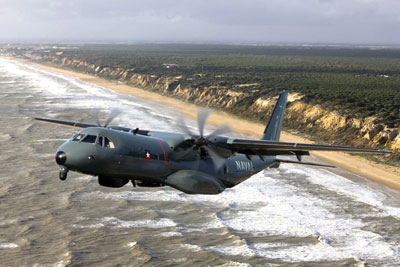 |
|
| Chile is one of several countries using the twin-engine C-295 in the long-range maritime patrol role. Photo: AIRBUS |
Cascade also provides fleet management services directly to the RCAF for its legacy model C-130 fleet. In front of a large gathering of VIPs including federal and provincial cabinet ministers, George Schulz, Lockheed Martin VP and general manager for C-130 programs extolled the dedication of Cascade Aerospace in supporting the RCAF C-130 fleet and now rising to meet the demands of the world market. In response, David Schellenberg, CEO of Cascade Aerospace described the designation as an honour and a privilege for Cascade. It’s a solid partnership that certainly helps make the CC-130J a solid contender for the FWSAR contract.
Delivering the goods
Both Airbus and Lockheed Martin are highly capable international companies with long histories of supplying aircraft to the Canadian military – and their Canadian in-service partners are equally strong and established. The EADS/CASA C-295 and Lockheed Martin C-130J are both highly capable aircraft with solid international successes to illustrate their worthiness as solid FWSAR options. And while a final decision has yet to be made, one thing is certain – the Buffalos and legacy Hercs aren’t getting any younger. A decision needs to be made soon – our courageous SAR teams from coast to coast deserve it.
Editor’s note: In the March/April issue of Wings we will profile the Alenia Aermacchi C-27 Spartan and the Bell-Boeing V-22 Osprey.